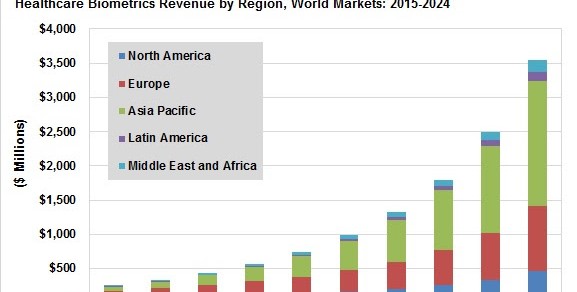Biometrics health care market worth $3.5 billion by 2024
18 August, 2015
category: Biometrics, Health
Health care could be one of the best opportunities for biometric vendors, according to a report from consultancy Tractica.
Starting from a base of $250 million in 2015, the firm forecasts that global health care biometrics revenue will reach $3.5 billion by 2024, with cumulative revenue for the 10-year period totaling $12.5 billion. Key health care use cases, which will drive adoption of biometrics hardware and software in the industry, will include home/remote patient access, care provider authentication, patient identification and tracking, and pharmacy dispensing.
The report examines four different use cases specific to health care, with a focus on biometrics to identify and authenticate people, rather than diagnosing or treating patients.
Three of these use cases are caregiver facing, and one of which is consumer-facing. The consumer use case of accessing personal medical information from home or remote locations is likely to be a low-price but high-volume software solution, and is forecast to generate approximately 60% of total revenue. By comparison, the three caregiver-facing use cases are mostly hardware-driven, with much higher unit prices, but lower volumes.
Biometrics will serve the health care industry with both hardware and software solutions, but at a distance. Biometrics will be embedded in medical devices or systems that are embedded into business solutions for health care facilities and networks.
That implies several levels of sales channels. Biometrics vendors will need to understand what is going on at each level, but will likely only sell directly to device manufacturers or application developers.
Understanding those sales channels is the key to success in this market. Biometrics vendors must build strong relationships with their direct customers in the health care market. Those relationships have to be strong technically, in terms of an easy integration of the biometrics hardware or software into the client’s product. And those relationships have to be strong personally.
Biometrics device makers and application developers will have their pick of many modalities and competing technologies within a single modality. They are likely to go with the biometrics products that are easiest for them to integrate, including the perceived relationship between vendor and client.
An executive summary of the report can be downloaded here.




